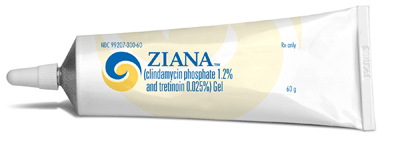Product
Ziana
Approval Date
November 7, 2006
Release Date
Jan. 4, 2007
Company
Medicis
Class
Topical antibiotic (lincosamide) + retinoid
Active Ingredient
Clindamycin phosphate 1.2%; tretinoin 0.025%; gel.
Indication
Acne vulgaris
Agency Roster
Donahoe Purohit Miller (professional)
MarketingStrategy/Execution
Medicis, which prides itself on its dermatology specialization,began promoting Ziana to physicians in late 2006/early 2007. The Medicis gel, combiningantibiotic clindamycin with a retinoid, could simplify the treatment regimenfor acne patients. The market for topical acne care totaled about $1.4 billion lastyear, with the combo market about half that, per IMS Health. Medicis hasstressed its awareness of the influence of dermatologists in making a brandchoice: derms wrote about 50% of scripts, or approximately $800 million of thebranded and generic dollars, the firm said.
The Market
| Acne w/anti-infectant, antiseptic US sales ($000s) last 5 years | |
| 2006 | $792,853 |
| 2005 | $734,693 |
| 2004 | $639,959 |
| 2003 | $587,610 |
| 2002 | $528,910 |
| Source: IMS Health, Oct. 2007 |
|
| Top 5 acne w/anti-infectant, antiseptic | ||
| Jan.-July ’07 US sales ($000s) | % sales growth over Jan.-July ‘06 | |
| BENZACLIN (Dermik) | $119,346 | 3% |
| DUAC (Stiefel) | $74,174 | 8% |
| ZIANA (Medicis) | $31,938 | *** |
| FINACEA (Intendis) | $26,721 | 16% |
| EVOCLIN (Stiefel) | $22,302 | 7% |
| Source: IMS Health, Oct. 2007 |
||
Physician Outlook
According to our research, as of July 2007, more than 50% ofdermatologists surveyed were prescribingnewly launched Ziana, and over a third of derms expected to increaseprescribing in the next six months. The drug is being used primarily in thetreatment of moderate acne and for maintenance therapy.
—Sue Ramspacher, senior VP, category leader, dermatology,GfK Market Measures, Oct. 2007
Also in the Pipeline(according to Adis R&D Insight)
Drug: Alesse/Loette
Manufacturer: Wyeth
Active ingredient: Ethinylestradiol/levonorgestrel
Indication: Acne vulgaris
Phase: Filed
Drug: N574/Papulex
Manufacturer: GenDerm Corporation/Abbott
Active ingredient: Nicotinamide
Indication: Acne vulgaris
Phase: Filed
Source: Wolters Kluwer Health, Oct. 2007
Recent MM&MCoverage
ProductNews from the 11/14/06 News Brief
Pharmacology
Ziana is a topical gel for acne that combines clindamycinand tretinoin. Clindamycin is a lincosamide antibiotic that inhibits bacterialprotein synthesis. It has been shown to have in vitro activity against P.acnes. Tretinoin is a retinoid that has been shown to reduce microcomedoformation. It also reduces the cohesiveness and increases the turnover offollicular epithelial cells, causing extrusion of the comedones.
Clinical Trials
Three 12-week, prospective, randomized blinded studies, each involving over1,000 patients, were conducted to assess the safety and efficacy of Ziana inthe treatment of acne. In the first two studies, this combination product wascompared to clindamycin in the vehicle gel, tretinoin in the vehicle gel, andthe vehicle gel alone in treating patients with mild, moderate, or severe acnevulgaris. The combined results of Study 1 and Study 2 showed that 21% of thepatients using Ziana were evaluated as experiencing “success” (cleared oralmost cleared) at 12 weeks, compared to 8% for those using the vehicle alone.For those using clindamycin alone, 16% achieved “success”, and for those usingtretinoin alone, 14% of the patients achieved “success”. The percent reductionfrom baseline in mean total (inflammatory + non-inflammatory) lesion count was41% for the Ziana-treated patients, compared to 20% for the vehicle alone, 34%for both clindamycin and for tretinoin alone. Local side effects (eg, erythema,scaling, itching burning, and sting-ing) peaked at 2 weeks and then decreased.
In Study 3, the use of Ziana was compared to clindamycin gel in morethan 2,000 patients with moderate or severe acne vulgaris. In this study,“success” was assessed by the percentage of patients who had at least 2 gradesof improvement from baseline to week 12. For those patients using Ziana, 41%achieved “success,” compared to 34% for those patients using clindamycin gel.In the group of patients using Ziana, there was a 54% reduction from baselinein total lesion count compared to 47% in the clindamycin-treated group.
Adverse Reactions
Erythema, scaling, itching, burning, stinging,nasopharyngitis, throat pain, dry skin, cough, sinusitis; rare: diarrhea,colitis.
Adults
Apply thin film to clean, dry face once daily at bedtime.
Children
Not recommended.
Contraindications
Regional enteritis. Ulcerative colitis. History ofantibiotic-associated colitis.
Precautions
Sunburn (allow to heal before using). Avoid sun, UV light(use sunscreen and adequate sun protection daily). Avoid eyes, mouth, angles ofnose, mucous membranes. Discontinue if significant diarrhea occurs. Increasedirritation in extreme weather. Pregnancy (Cat.C). Nursing mothers: notrecommended.
Interactions
Avoid erythromycin. Additive irritation with other topicalproducts (eg, alcohol, drying agents, lime). May potentiate neuromuscularblockers. Caution with other photosensitizers (eg, tetracyclines, quinolones).









